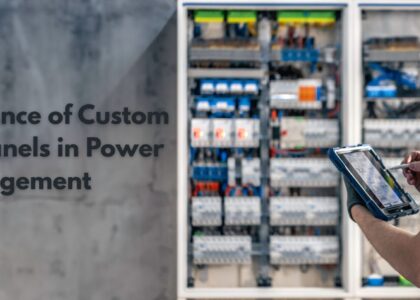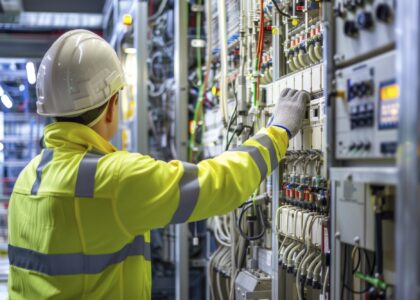In today’s digital age, the electrical infrastructure of industrial and commercial facilities is evolving rapidly. With increasing demands for energy efficiency, operational reliability, and real-time monitoring, the integration of automation technologies into electrical systems is not just a trend but a necessity. One area seeing a significant transformation is in LV (Low Voltage) and MV (Medium Voltage) panels. The adoption of automation control panels in these segments is revolutionizing how facilities manage, monitor, and control their power distribution.
This blog explores how integrating automation into LV and MV panels elevates their functionality. From improved safety and energy efficiency to smarter data utilization and remote access, automation is the key to modernizing electrical panel operations.
Key Takeaways
1. Automation control panels enhance performance, safety, and efficiency in LV and MV systems.
2. Smart electrical panels provide real-time data, diagnostics, and remote control.
3. LV panel automation reduces manual intervention and improves maintenance strategies.
4. MV panel integration with automation enhances load management and fault detection.
5. Ideal for industries seeking scalable, reliable, and intelligent power solutions.
Table of Contents
Understanding LV/MV Panels
LV panels manage electrical distribution for voltages below 1,000 volts, typically for residential, commercial, and industrial buildings. MV panels, on the other hand, handle voltages between 1,000 and 35,000 volts, often used in substations, large industrial facilities, and utility grids.
Traditionally, these panels operated with limited intelligence — performing basic distribution, protection, and metering tasks. But with today’s increased power demands and the push for smarter systems, these limitations are no longer acceptable.
The Rise of Automation in Electrical Systems
Automation has emerged as a game-changer across industries, and the electrical domain is no exception. Integrating automation control panels into electrical systems enables centralized monitoring, advanced diagnostics, predictive maintenance, and enhanced control.
The Industrial Internet of Things (IIoT), cloud computing, and machine learning are driving this shift toward automation. These technologies are embedding intelligence into traditional power systems, converting them into smart electrical panels capable of real-time decision-making.
What Are Automation Control Panels?
Automation control panels are electrical enclosures housing components such as PLCs (Programmable Logic Controllers), relays, HMI (Human-Machine Interface) devices, and communication interfaces. These panels monitor and control the electrical parameters and processes within a facility.
Whether for HVAC systems, water treatment plants, or energy distribution, automation control panels play a vital role in reducing human intervention, improving process accuracy, and delivering actionable data insights.
Key features include:
1. Remote access and monitoring
2. Real-time fault detection
3. Load balancing
4. Predictive analytics
Benefits of Smart Electrical Panels
Smart electrical panels provide more than just electricity distribution—they are intelligent systems capable of optimizing energy flow. Here’s what they offer:
1. Energy Efficiency: Track energy usage and reduce waste.
2. Safety: Instant notifications of errors, overloads, or illegal access.
3. Remote Monitoring: Access from anywhere using web or mobile applications.
4. Data-Driven Decisions: Analyze usage patterns to improve operational efficiency.
5. Maintenance Planning: Predict issues before they cause downtime.
These features make smart panels the ideal foundation for LV panel automation and MV panel integration.
LV Panel Automation: Applications and Advantages
LV panel automation enables precise control over low voltage circuits, which is critical for lighting, HVAC systems, fire alarms, and more. Here are some core advantages:
1. Improved Reliability: Automated switching reduces dependency on manual operations.
2. Enhanced Safety: Auto shut-offs prevent hazards during faults.
3. Reduced Operational Costs: Automated panels require fewer technicians for routine checks.
4. Customization: Tailored to specific facility needs.
5. Load Shedding and Demand Control: Efficient use of available energy.
Industries using LV panel automation include:
1. Commercial buildings
2. Hospitals
3. Educational institutions
4. Manufacturing units
MV Panel Integration: Performance and Safety
Medium voltage systems are critical for large-scale operations. Integrating automation in MV panels brings about significant performance enhancements:
1. Advanced Protection Schemes: Quick fault isolation and system restoration.
2. Condition Monitoring: Detect temperature rise, insulation failure, or arc faults early.
3. Remote Operation: Control high-voltage systems from safe distances.
4. Data Logging: Enables audits, compliance checks, and historical analysis.
MV panel integration is crucial for:
1. Utilities
2. Data centers
3. Power plants
4. Heavy industries
Key Components in Automated Panels
Both LV and MV automation systems rely on the following components:
1. Programmable Logic Controllers (PLCs)
2. Human-Machine Interface (HMI)
3. Sensors and Transducers
4. IoT Gateways
5. SCADA Systems
6. Communication Modules (Ethernet, Modbus, etc.)
7. Intelligent Relays and Contactors
These elements form the core of any modern automation control panel.
Industry Applications of Automated LV/MV Panels
From production to distribution, various industries are reaping the benefits of smart panel automation:
1. Oil & Gas: Safer and more reliable substation control
2. Water Treatment: Optimized pump and valve control
3. Pharmaceutical: Precise environmental control
4. Infrastructure Projects: Scalable power distribution
5. Renewable Energy: Grid synchronization and load control
Automation enhances operational efficiency and reduces downtime in each case.
Challenges and Considerations
While the benefits are numerous, there are some considerations:
1. Initial Investment: Higher upfront cost for automation equipment
2. Training Needs: Operators need to be trained on new interfaces
3. Cybersecurity: Smart panels must be protected from digital threats
4. Integration Complexity: Especially in retrofitting old systems
Choosing the right automation partner and equipment is crucial to overcoming these challenges.
Future of Automation in Power Management
The future of automation control panels lies in deeper integration with AI and machine learning. Here’s what we can expect:
1. Self-Healing Networks: Automated rerouting during faults
2. Decentralized Control: Using edge computing
3. Green Energy Management: Integration with solar, wind, and EV systems
4. Enhanced Cybersecurity Protocols
The trajectory is clear: automation will dominate the future of LV/MV panels.
Final Thoughts
As energy systems grow in complexity, the need for intelligent, adaptable, and efficient power distribution becomes essential. Integrating automation control panels within LV and MV panels transforms conventional systems into smart electrical panels that not only meet current operational demands but also anticipate future needs.
Whether you’re managing a manufacturing plant, a commercial complex, or a data center, automation provides the tools to optimize safety, reduce costs, and improve control. Embrace LV panel automation and MV panel integration to take a step toward a more efficient and smarter energy future.
Looking to implement smart automation in your power systems?
Explore the range of industry-ready products, like AC Distribution Boards, RTCC Panels, Control and Relay Panels, and more, that are intended for intelligent LV/MV operations.
Discover how Digital Electric’s panels support real-time monitoring, fault diagnostics, and seamless SCADA integration.
Check out our full product range:
1. Control and Relay Panels – Essential for intelligent automation and protection in MV systems.
2. RTCC Panel (Remote Tap Changer Control) – Supports automation in transformer control.
3. AC Distribution Board – Forms a core part of LV panel automation.
4. Transformer Marshalling Box – For organizing control wiring and enhancing safety.
5. AC/DC DB (Distribution Boards) – Integrates with automation systems for load management.
FAQs
What are automation control panels, and how do they help in LV/MV systems?
Automation control panels are intelligent electrical enclosures that manage and monitor various systems. In LV and MV systems, they help enhance safety, efficiency, and real-time control through programmable logic, remote monitoring, and predictive diagnostics.
How do smart electrical panels differ from traditional panels?
Smart electrical panels offer real-time data, automated control, and remote access. Unlike traditional panels, they provide insights into energy usage and system health, helping with timely maintenance and efficiency improvements.
Why is LV panel automation important for commercial buildings?
LV panel automation improves safety, reduces downtime, and ensures precise control over power distribution in buildings, especially for systems like lighting, HVAC, and fire protection.
What is MV panel integration, and where is it typically used?
MV panel integration refers to embedding automation systems into medium voltage panels, enabling safer and smarter operation in high-load environments like data centers, utilities, and manufacturing plants.
Are automation control panels expensive to implement?
The upfront cost of automation control panels may be higher, but they reduce long-term maintenance costs and energy waste, making them cost-effective in the long run.
How secure are smart electrical panels against cyber threats?
Modern smart electrical panels come with advanced cybersecurity features like firewalls, encrypted communications, and authentication protocols to protect against unauthorized access.
Can existing LV/MV panels be upgraded with automation?
Yes, retrofitting is possible. You can integrate LV panel automation and MV panel integration features into existing systems with the help of expert panel designers and automation specialists.
What industries benefit the most from automation control panels?
Industries like oil & gas, pharmaceuticals, water treatment, infrastructure, and renewable energy gain massive operational advantages from automation control panels and smart electrical panels.
Do I need skilled technicians to operate automated panels?
Basic training is needed, but modern automation control panels are designed with user-friendly HMIs and interfaces, minimizing the learning curve.
What future trends should we expect in automation control for LV/MV systems?
Expect advancements like self-healing grids, AI-powered diagnostics, and seamless integration with smart electrical panels, renewable energy systems, and real-time analytics platforms.



